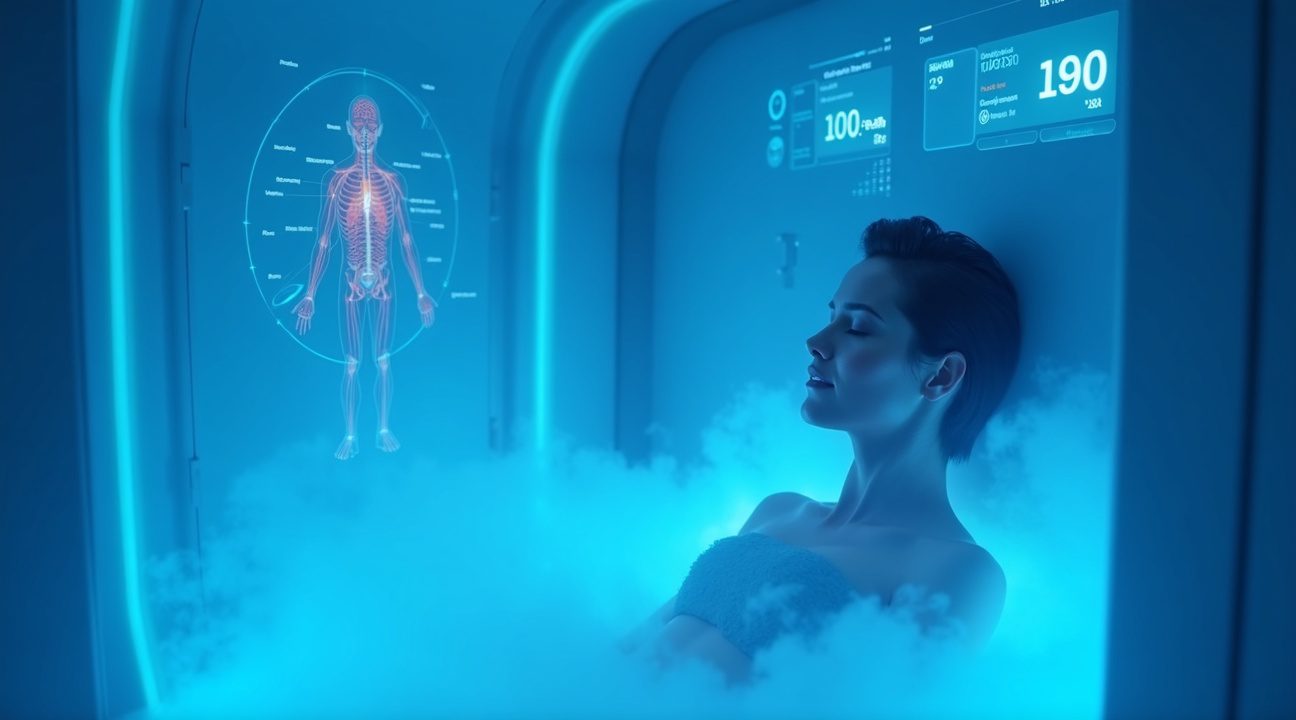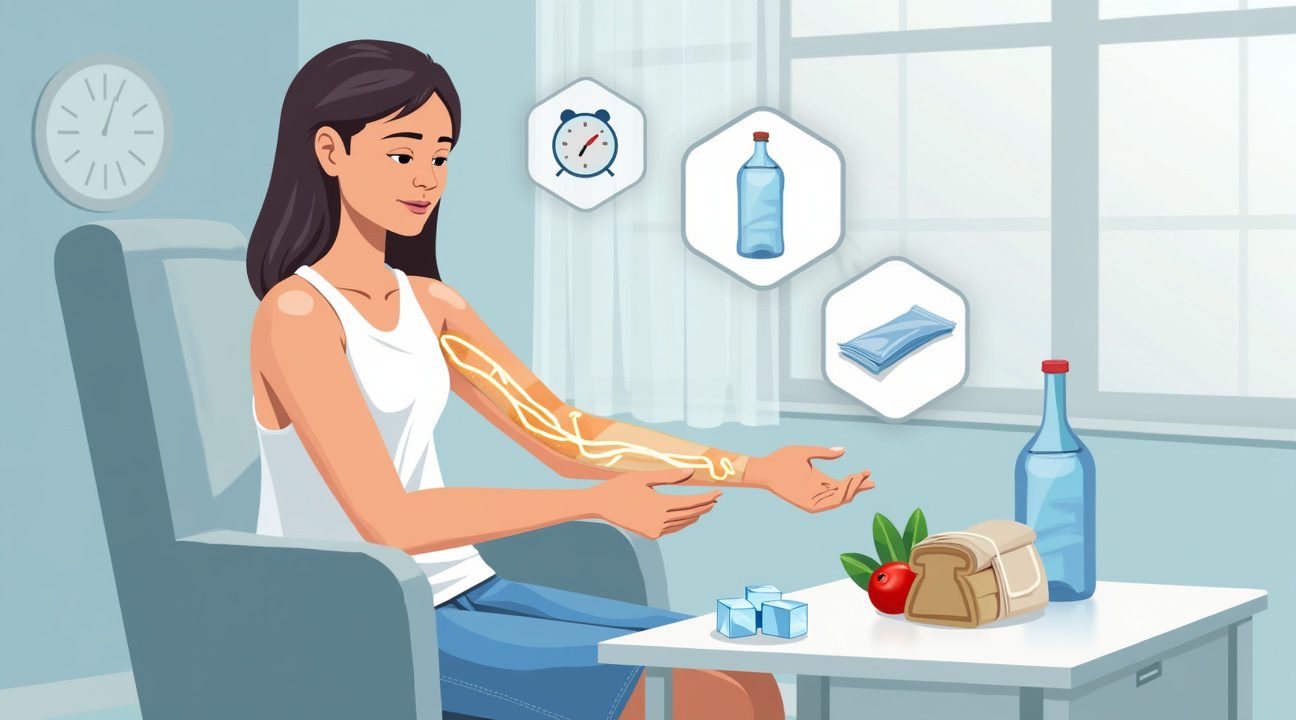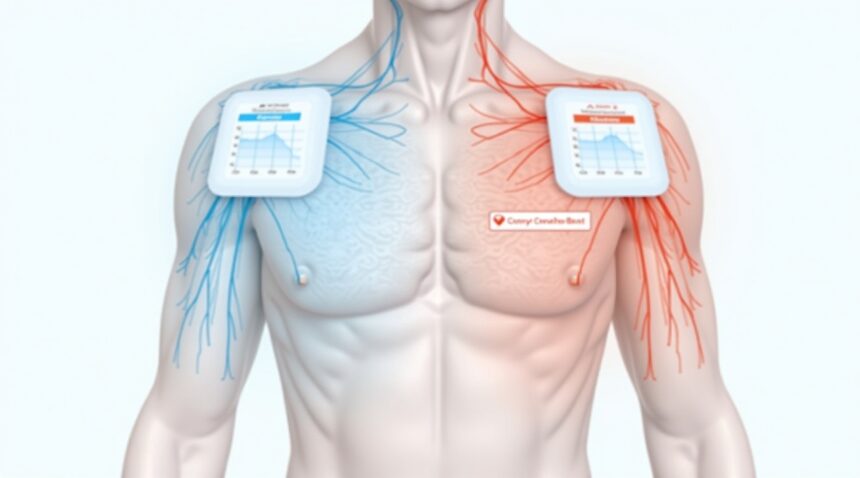Placing something cold under your arms activates a fascinating two-phase nervous system response that rapidly shifts your body from stress to calm.
Cold exposure initiates a short period of sympathetic nervous system activation—also known as the “fight or flight” response. However, this is quickly followed by a shift toward parasympathetic dominance, often referred to as the “rest and digest” state. This transition occurs through arterial baroreflex activation, leading to remarkable physiological effects such as a reduction in heart rate by up to 15% and a noticeable increase in heart rate variability (HRV) within just a few minutes of application.
Key Takeaways
- Cold application under the arms triggers a rapid shift from sympathetic to parasympathetic nervous system control, promoting relaxation via arterial baroreflex activation.
- The armpit area yields optimal results due to the presence of major blood vessels near the skin surface, enabling fast transmission of cooling effects to the brain’s stress centers.
- Scientific research reveals immediate results, showing heart rate declines of 10–15% and increased HRV within 2–3 minutes of cold exposure under the arms.
- Effective technique includes use of a cloth-wrapped cold pack, applied directly into the underarm hollow for 1–3 minutes where pulse points are pronounced.
- Cold therapy enhances the impact of other stress-reduction practices such as deep breathing and meditation, creating a solid physiological base for emotional relaxation.
For more on how cold exposure supports nervous system regulation, explore research from the National Institutes of Health (NIH) that delves into the mechanisms of baroreflex sensitivity and autonomic balance.
The Science Behind Cold-Induced Calm: How Your Nervous System Responds to Temperature
Applying something cold under your arms triggers a fascinating cascade of physiological responses that ultimately lead to a calmer state. I’ve found this mechanism works because the underarm area contains blood vessels positioned close to the skin’s surface, making it an ideal location for temperature-based nervous system activation.
The Two-Phase Nervous System Response
Cold exposure initially activates cold-sensitive cutaneous receptors in your skin. These receptors immediately stimulate sympathetic α-adrenergic fibers, causing peripheral vasoconstriction as blood vessels narrow and redirect blood flow from your extremities back to your core organs. This immediate response represents your body’s protective mechanism against temperature changes.
The real magic happens in the second phase. Arterial baroreflex activation occurs as your cardiovascular system detects changes in blood pressure and volume distribution. This baroreflex response quickly shifts your autonomic nervous system from sympathetic dominance to parasympathetic control, effectively moving you from a state of alertness to relaxation.
Heart rate variability (HRV) measurements reveal how this process unfolds. While initial sympathetic activation causes changes in plasma norepinephrine levels, the subsequent parasympathetic dominance becomes evident through increased HRV indices. Your heart rate drops, breathing becomes deeper, and your overall stress response diminishes.
This dual-phase response explains why military sleep techniques often incorporate temperature regulation. Cold application under your arms creates a rapid transition from sympathetic to parasympathetic nervous system control, mimicking the natural progression your body follows when preparing for rest.
The parasympathetic nervous system’s activation through cold exposure offers practical benefits beyond simple relaxation.
- Blood redistribution patterns change
- Stress hormones decrease
- Your body enters a recovery-focused state
This response happens automatically once the baroreflex mechanism engages, requiring no conscious effort on your part.
Understanding this autonomic nervous system regulation helps explain why cold therapy works so effectively for stress management. The underarm application specifically targets areas where this temperature-sensitive response can be most efficiently triggered, making it a practical tool for activating your body’s natural calming mechanisms.
Research Proves Cold Therapy Creates Immediate Relaxation Effects
Scientific studies demonstrate that cold exposure triggers powerful physiological changes that promote relaxation within minutes. A single 3-minute cryostimulation session using Whole Body Cryotherapy at -110°C or Partial Body Cryotherapy at -160°C leads to immediate parasympathetic stimulation. This activation shows measurable results through increased heart rate variability and reduced heart rate ranging from -10.9% to -15.2% depending on the exposure type.
The Cold Face Test Reveals Vagus Nerve Activation
Researchers regularly use cold stimulation in laboratory settings through a protocol called the “Cold Face Test.” This test activates vagal (parasympathetic) pathways, which effectively reduce acute stress responses. The vagus nerve, when stimulated by cold exposure, triggers the body’s rest-and-digest response system. This mechanism explains why placing cold packs under the arms or on the face may harness similar calming effects in a portable, accessible way.
The military sleep method shares this principle of activating the parasympathetic nervous system for rapid relaxation. While research applications use extreme temperatures between -110°C and -160°C for approximately 3 minutes, domestic applications achieve comparable benefits using ice packs or cold compresses. These accessible alternatives make the technique available for everyday stress management.
Measurable Changes in Heart Function
Heart rate variability increases serve as a key indicator of parasympathetic activation during cold exposure. This measurement reflects the body’s ability to adapt and respond to stressors effectively. The documented heart rate reduction of up to 15% demonstrates the immediate impact cold therapy has on cardiovascular function. These changes occur rapidly, often within the first few minutes of cold application.
The underarm placement takes advantage of concentrated nerve pathways and blood vessels in this region. Blood flowing through these areas carries the cooling effect throughout the circulatory system, amplifying the parasympathetic response. This positioning also provides direct contact with lymph nodes, which may enhance the overall calming effect through additional physiological pathways.

Why the Armpit Area Works So Well for Cold Therapy
The armpit region serves as an optimal location for cold therapy due to its unique anatomical features and proximity to critical blood vessels. I’ve discovered that this area houses the axillary artery, one of the body’s major blood vessels that carries oxygenated blood directly from the heart. When cold is applied here, it creates an immediate pathway for temperature changes to reach the body’s core circulation system.
Strategic Blood Vessel Access and Rapid Temperature Changes
Cold therapy in the axilla works because of several key physiological factors:
- The thin skin in this area allows for efficient heat transfer
- Major arteries run close to the surface, creating direct access to circulation
- The lymphatic system is highly active in this region, supporting immune responses
- Nerve pathways that connect to the autonomic nervous system pass through this area
This anatomical design makes the armpit particularly effective for triggering rapid autonomic shifts. When I apply cold packs to this region, the temperature change travels quickly through the bloodstream, signaling the nervous system to activate the parasympathetic response. This shift moves the body away from the fight-or-flight state and encourages relaxation.
Sports medicine professionals have long recognized the effectiveness of axilla cooling for performance recovery and stress management. The technique works by enhancing vagal tone, which strengthens the body’s natural calming mechanisms. Unlike other body areas where cold application might take longer to create systemic effects, the armpit delivers almost immediate results due to its vascular accessibility.
Cold packs placed under the arms can produce measurable changes in heart rate variability within minutes. This rapid response makes the technique particularly valuable during acute stress situations or anxiety episodes. The cooling effect doesn’t just provide local relief – it creates a cascade of physiological changes that promote whole-body relaxation.
The proximity to the vagus nerve network amplifies these calming effects. As blood temperature drops in the axillary region, it sends signals to the brain that help activate the rest-and-digest response. This natural process can be especially beneficial for those who need quick stress relief or want to transition from high-energy activities to relaxation periods.
Understanding this anatomical advantage helps explain why military sleep techniques and other rapid relaxation methods often incorporate temperature regulation strategies. The armpit’s unique combination of blood vessel access, nerve proximity, and efficient heat transfer makes it an ideal target for cold therapy interventions.
Step-by-Step Guide to Using Cold Packs for Stress Relief
Activating the body’s natural calming response through strategic cold application requires proper technique and understanding of target areas. The process targets major blood vessels located beneath the arms, which directly influences the autonomic nervous system’s response to stress.
Proper Application Technique
First, wrap any cold pack or ice pack in a thin cloth or towel to prevent direct skin contact and potential frostbite. Place the wrapped cold compress firmly under one or both arms, positioning it directly against the armpit area where major blood vessels run close to the skin’s surface. Hold the cold pack in place for 1–3 minutes, allowing the cooling sensation to penetrate the area.
Remove the cold pack and assess your stress levels. Many people notice an immediate sense of calm as the vagus nerve responds to the temperature change. Repeat the application as needed throughout stressful situations, typically allowing 5–10 minutes between applications to prevent skin irritation.
Maximizing Effectiveness Through Strategic Targeting
The success of this technique lies in understanding which areas provide maximum autonomic nervous system impact. Major blood vessels under the arms respond quickly to temperature changes, sending immediate signals to the brain’s stress response centers. Similar techniques like the military sleep method demonstrate how simple physical interventions can profoundly affect mental states.
Duration plays a crucial role in effectiveness:
- Sessions lasting less than one minute may not provide sufficient stimulus.
- Applications exceeding three minutes can cause discomfort without additional benefits.
- The sweet spot typically falls between 90 seconds and 2.5 minutes for most individuals.
This method shares similarities with the Cold Face Test, another technique that activates the parasympathetic nervous system through temperature manipulation. Both approaches work by stimulating the dive reflex, an evolutionary response that automatically slows heart rate and promotes relaxation.
Accessibility makes this technique particularly valuable during acute stress episodes:
- Ice packs from freezers
- Cold water bottles
- Frozen vegetables wrapped in cloth
All of these items can serve as effective tools. Keep cold compresses readily available in office refrigerators or home freezers for immediate stress relief when needed.
The positioning doesn’t require perfect precision, but focusing on the hollow area directly under the arm where pulse points are strongest yields the best results. Some individuals find alternating between arms every minute provides enhanced benefits, though single-arm application remains equally effective for most stress relief purposes.

How Cold Therapy Compares to Other Calming Techniques
Cold stimulation under the arms represents one pathway among several proven methods for activating the body’s natural calming system. Other established techniques include paced breathing, meditation, massage, deep muscle relaxation, and spending time in nature. Each method targets the parasympathetic nervous system through different mechanisms, creating a comprehensive toolkit for stress management.
Physical vs. Behavioral Approaches to Calming
Cold exposure to the face and underarm areas offers an immediate, physical route to nervous system calming that complements behavioral methods perfectly. This is particularly valuable because it doesn’t require the mental focus that meditation or breathing exercises demand. While breathwork and mindfulness practices develop over time with consistent practice, cold stimulation provides instant physiological changes that can be felt within seconds.
Breathwork and cold exposure both elevate heart rate variability (HRV) and reduce stress markers, making them powerful allies in stress management. Alternating muscle contractions synchronized with paced breathing can increase parasympathetic signal by up to 150% over control conditions. This combination approach leverages both the immediate physical response of cold therapy and the sustained benefits of controlled breathing patterns.
Complementary Techniques for Enhanced Results
Modern stress management benefits from combining multiple approaches rather than relying on a single technique. The following methods work synergistically with cold therapy to maximize parasympathetic activation:
- Mindfulness meditation helps train awareness of the body’s stress responses
- Massage therapy releases physical tension while promoting relaxation hormones
- Gentle movement practices like yoga or tai chi integrate breath with physical activity
- Aromatherapy using lavender, rose, or chamomile essential oils engages the olfactory system
- Biofeedback apps provide real-time data on stress indicators and recovery progress
Cold therapy stands out because it requires no special training or extended time commitment. Unlike sleep optimization techniques that take weeks to establish, placing something cold under the arms activates the vagus nerve within moments. This makes it particularly useful during acute stress situations where breathing exercises might feel overwhelming or impractical.
The beauty of cold stimulation lies in its compatibility with other calming methods. It can be combined with deep breathing exercises for amplified effects, or used as a quick reset before transitioning into meditation practice. Research shows that quality sleep patterns improve when the nervous system receives regular parasympathetic activation throughout the day.
Deep muscle relaxation techniques require learning to systematically tense and release muscle groups, which takes practice to master effectively. Cold therapy bypasses this learning curve entirely by directly stimulating nerve pathways that signal the brain to activate rest-and-digest responses. This makes it an excellent bridge technique for people just beginning their stress management journey.
Time in nature remains one of the most powerful calming interventions available, but it’s not always accessible in urban environments or during busy schedules. Cold therapy provides a portable alternative that can be implemented anywhere, whether at work, home, or while traveling. The physiological response remains consistent regardless of environment, making it a reliable tool for consistent stress management.
Biofeedback applications have revolutionized how people understand their stress responses by providing real-time measurements of heart rate variability, breathing patterns, and other autonomic indicators. Cold therapy integrates seamlessly with these monitoring tools, allowing users to observe immediate changes in their nervous system function. This visual feedback reinforces the effectiveness of the technique and helps build confidence in its stress-reducing capabilities.
The key advantage of incorporating cold stimulation into a broader stress management strategy is its role as both a standalone intervention and an enhancement to other techniques. While massage requires scheduling appointments and meditation demands quiet environments, cold therapy adapts to any situation where stress management becomes necessary.
Combining Cold Application with Other Stress Management Strategies
Cold application under the arms works exceptionally well when paired with other stress management techniques, creating a powerful combination that addresses both immediate and long-term stress relief needs. The physical cooling effect triggers rapid neurophysiological changes, including improved heart rate variability and reduced heart rate, which perfectly complement behavioral relaxation strategies.
I’ve found that the immediate relief from cold therapy creates an ideal foundation for deeper relaxation techniques. When someone places ice packs or cold towels under their arms, the body’s parasympathetic nervous system begins activating within minutes. This physiological shift makes it easier to engage in breathing exercises, meditation, or progressive muscle relaxation because the body is already moving into a calmer state.
Strategic Integration Methods
The most effective approaches combine cold application with complementary techniques that work on different aspects of the stress response:
- Start with cold application for 2–3 minutes to initiate physiological calming
- Follow with deep breathing exercises while maintaining the cold contact
- Practice mindfulness meditation during the cooling period to enhance mental clarity
- Use progressive muscle relaxation after removing the cold application
- Incorporate visualization techniques while the parasympathetic effects are strongest
Cold therapy provides the immediate neurophysiological foundation, while techniques like the military sleep method offer sustained benefits for long-term stress management. The HRV changes from cold exposure create optimal conditions for these behavioral interventions to take effect more quickly and powerfully.
I recommend timing the integration carefully. The cold application should come first because it creates measurable physiological changes that enhance the effectiveness of subsequent techniques. Heart rate reduction from cold exposure makes breathing exercises more effective, while the parasympathetic activation improves focus for meditation practices.
The synergistic effect occurs because cold therapy addresses the physical stress response directly through the nervous system, while behavioral techniques work on cognitive and emotional aspects of stress. This dual approach maximizes parasympathetic nervous system activation by targeting multiple pathways simultaneously.
Research on neurophysiological effects shows that combining these approaches creates more sustained benefits than using either method alone. The immediate relief from cold application prevents stress hormones from escalating, while behavioral techniques help maintain the relaxed state long after the cold stimulus is removed.
I’ve observed that people who use this integrated approach report faster onset of relaxation and longer-lasting effects. The cold application acts as a reset button for the nervous system, making subsequent relaxation techniques more accessible even for those who typically struggle with traditional stress management methods.
For optimal results, I suggest experimenting with different combinations to find what works best for individual needs. Some people respond well to cold application followed by gentle movement or stretching, while others prefer combining it with quality sleep preparation techniques. The key is maintaining the cold contact long enough to trigger the physiological response while transitioning smoothly into complementary practices.
The integration approach also helps build a more comprehensive stress management toolkit. Cold application can serve as an emergency intervention for acute stress, while the paired behavioral techniques provide ongoing support for chronic stress management. This combination ensures that both immediate relief and long-term resilience are addressed through a single, coordinated strategy.
Sources:
PLOS ONE, “Parasympathetic Activity and Blood Catecholamine Responses to Different Modalities of Cold Exposure in Man”
Canyon Vista Recovery Center, “Activating the Parasympathetic Nervous System”
National Institutes of Health (PMC), “Effects of Cold Stimulation on Cardiac-Vagal Activation in Healthy Humans”
PubMed, “A Pilot Study of Paced Breathing and Dynamic Muscle Contraction on Parasympathetic Activation”
National Institutes of Health (PMC), “Vagus Activation by Cold Face Test Reduces Acute Psychosocial Stress: Evidence from Healthy Volunteers”
Heal Your Nervous System, “55 Techniques to Activate Your Parasympathetic Nervous System and Lower Stress”


